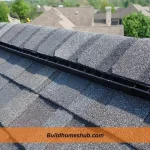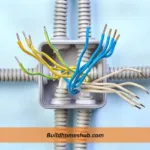Small cracks in a concrete flat roof can be unsightly and can lead to leaks if left unrepaired. Fortunately, it is relatively easy to repair small cracks in a concrete flat roof, as long as you have the right materials and follow the proper steps. In this guide, we will walk you through the process of repairing small cracks in a concrete flat roof.
How to Repair Concrete Roof Cracks
What you’ll need
To repair small cracks in a concrete flat roof, you will need the following materials:
- Concrete repair compound
- Concrete bonding agent
- Water
- Cleaning solution (such as soap or detergent)
- Putty knife or trowel
- Wire brush
- Sandpaper
Here is a step-by-step guide on how to repair the cracks on your concrete roof:
- Clean the area around the crack with a cleaning solution and a wire brush. This will remove any dirt, debris, or loose material that could prevent the repair compound from bonding properly.
- Dry the area completely.
- If the crack is deep, fill it with a concrete bonding agent. This will help the repair compound bond to the sides of the crack.
- Mix the concrete repair compound according to the manufacturer’s instructions.
- Using a putty knife or trowel, apply the repair compound to the crack. Spread it evenly over the surface of the crack, filling it completely.
- Smooth the surface of the repair compound with a trowel or putty knife.
- Allow the repair compound to cure according to the manufacturer’s instructions.
- Once the repair compound has cured, sand the surface of the repair with sandpaper to smooth it out and make it even with the surrounding concrete.
- If necessary, apply a concrete sealer to protect the repair and extend its lifespan.
It is important to follow the manufacturer’s instructions carefully when using concrete repair compounds, as different products may have different requirements for mixing, applying and curing.
If the cracks in your concrete flat roof are large or if the roof is showing other signs of damage, it may be necessary to hire a professional contractor to assess and repair the roof.
What Can I Use to Seal a Leaking Crack on Roof?
There are several options you can use to seal a leaking crack on a roof:
1. Roofing cement
Roofing cement is a type of sealant that can be used to permanently repair cracks in your roof. It’s made up of asphalt, which is a type of plastic material used in the construction industry.
While there are other types of adhesives and sealants on the market that work well to stop leaks, they usually don’t last very long before needing to be reapplied or replaced. Roofing cement offers superior protection against moisture penetration due to its ability to adhere tightly without breaking down over time as other products do.
The best thing about using this product is that it doesn’t require any special tools or equipment, just some simple tools you probably already have around your house.
How to use roofing cement to seal leaked crack on roof
To use roofing cement to seal a leaked crack on a roof, follow these steps:
- Clean the area around the crack with a cleaning solution and a wire brush. This will remove any dirt, debris, or loose material that could prevent the roofing cement from bonding properly.
- Dry the area completely.
- Scoop a small amount of roofing cement onto a trowel or putty knife.
- Hold the trowel or putty knife at a 45-degree angle and press the roofing cement into the crack, filling it completely.
- Smooth the surface of the roofing cement with the trowel or putty knife.
- Repeat the process for any additional cracks or gaps on the roof.
It is important to ensure that the area is clean and dry before applying the roofing cement, as the cement may not bond properly to a dirty or wet surface.
2. Roofing tape
This is a flexible, self-adhesive tape that can be used to seal cracks and gaps in roofing materials. It is applied by pressing it firmly into place and smoothing it out with a roller.
How to use roofing tape to seal leaked crack on roof
To use roofing tape to seal a leaked crack on a roof, follow these steps:
- Clean the area around the crack with a cleaning solution and a wire brush. This will remove any dirt, debris, or loose material that could prevent the roofing tape from bonding properly.
- Dry the area completely.
- Cut a piece of roofing tape to the appropriate size for the crack. The tape should be slightly larger than the crack, with enough overlap to ensure a secure seal.
- Peel the backing off of the roofing tape and position it over the crack.
- Press the tape firmly into place, smoothing it out with a roller to remove any air pockets or wrinkles.
- Repeat the process for any additional cracks or gaps on the roof.
It is important to ensure that the area is clean and dry before applying the roofing tape, as the tape may not bond properly to a dirty or wet surface. Additionally, be sure to follow the manufacturer’s instructions carefully when using roofing tape, as different products may have different requirements for application and handling.
3. Roofing sealant
This liquid sealant is applied to the roof’s surface using a caulking gun. It dries to a flexible, waterproof finish that can withstand movement and expansion.
How to use roofing sealant to seal leaked crack on roof
To use roofing sealant to seal a leaked crack on a roof, follow these steps:
- Clean the area around the crack with a cleaning solution and a wire brush.
- Dry the area completely.
- Shake the roofing sealant well to ensure that it is properly mixed.
- Cut the tip of the roofing sealant tube to the appropriate size for the crack. A larger tip will produce a wider bead of sealant, while a smaller tip will produce a narrower bead.
- Load the roofing sealant into a caulking gun.
- Hold the caulking gun at a 45-degree angle and apply the roofing sealant to the crack, filling it completely.
- Smooth the surface of the roofing sealant with a putty knife or trowel.
- Repeat the process for any additional cracks or gaps on the roof.
4. Roof patch
This is a pre-formed patch that is designed to fit over holes and cracks in roofing materials. It is typically made of rubber or asphalt-based material, and it is applied by pressing it firmly into place and smoothing it out with a roller.
How to use roofing patch to seal leaked crack on roof
To use a roofing patch to seal a leaked crack on a roof, follow these steps:
- Clean the area around the crack with a cleaning solution and a wire brush. This will remove any dirt, debris, or loose material that could prevent the roofing patch from bonding properly.
- Dry the area completely.
- Cut a piece of roofing patch to the appropriate size for the crack. The patch should be slightly larger than the crack, with enough overlap to ensure a secure seal.
- Peel the backing off of the roofing patch and position it over the crack.
- Press the patch firmly into place, smoothing it out with a roller to remove any air pockets or wrinkles.
- Repeat the process for any additional cracks or gaps on the roof.
Final Thoughts
Repairing small cracks in a concrete flat roof is a relatively simple process that can be accomplished with a few basic tools and materials. By following the steps outlined in this guide, you can effectively repair small cracks and prevent leaks on your concrete flat roof. However, if the cracks in your roof are large or if the roof is showing other signs of damage, it may be necessary to hire a professional contractor to assess and repair the roof.
In any case, it is important to address small cracks promptly in order to prevent further damage and maintain the integrity of your roof.
I like to think I can help you with all the information you need on home renovations and DIY tips. You should subscribe.











